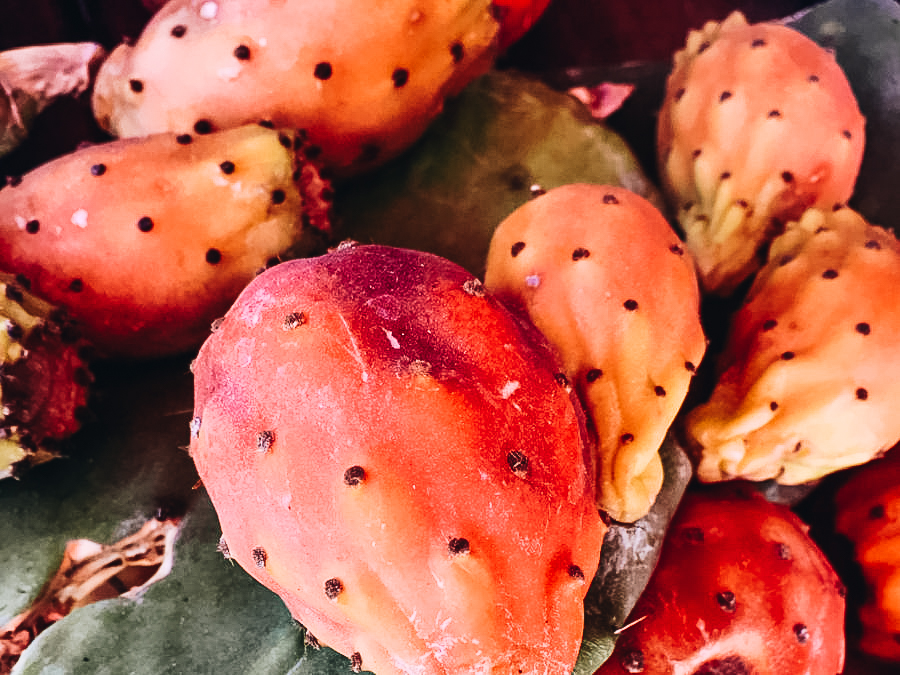The food of Mexico is always tasty, and sometimes an unexpected adventure. This is the case with the prickly pear cactus (aka: the Mexican tuna fruit). While its name may make you think of seafood, it is far from being aquatic. Nestled within the prickly embrace of cacti, you will find this fruit with its fiery hues and spiky armor that conceals a juicy, crimson treasure within.
Let’s discover the origins of this exotic fruit steeped in rich cultural heritage and ancient traditions, its health benefits, and how to best savor the culinary wonders this tropical gem has to offer.

The Mexican Tuna Fruit is from the Prickly Pear Cactus (Red & Green Varieties)
What Is Mexican Tuna Fruit?
Mexican tuna fruit, also known as prickly pear fruit or Opuntia fruit, is a fruit that comes from the prickly pear cactus (or nopal.) It is native to Mexico and widely cultivated for its edible fruit (which is called tuna in Spanish.) The fruit is characterized by its vibrant colors, ranging from green to red to purple and yellow, and its unique texture, featuring numerous small seeds embedded in the flesh.

What Varieties of Tuna Fruit are There?
The green (tunas verdes) and red (tunas rojas) prickly pear fruits are two of the most common varieties seen in the US. In Mexico, there are several other types of tunas, each with their unique flavors and colors:
- Tuna Amarilla: yellow in color, and has a sweet flavor.
- Roja Pelona: smaller seeds compared to other tunas; has a kiwi-like flavor.
- Cardona: purple skin and flesh with soft seeds.; has a bitter-sweet taste.
- Cuerno de Venado: has a ‘floral’ flavor, with high water content and small seed size.
- Platanera: a banana-like tuna with a sweet and juicy flavor.
- Xoconostle: this one is sour and chewy, often used in savory stews, salsas, and beverages.
These are just some of the many other kinds of tunas found in Mexico, so be sure to keep your eyes peeled for new ones during your visit.

How do you know when tuna fruit is ripe?
While there are lots of different tuna varieties, they all share a few tell-tale signs that the fruit is ripe.
- Firm to the touch when lightly squeezed.
- No bruises or signs of decay.
- Has a solid, vibrant color with no green (except for the green varieties, which turn a lighter shade when ripe.)
- Almost always no longer contain their prickles.

How Do You Eat Mexican Tuna Fruit
There are lots of ways you can eat Mexican tuna fruit. The most common method is by removing the skin and spines, then slicing the fruit into wedges or cubes. It can be enjoyed raw, added to salads, made into juices and jams, or used as an ingredient in desserts. As a Mexican street food, vendors usually add some chili sauce to sliced tuna cactus fruit.

Do You Eat the Seeds in Tuna Fruit
The seeds in tuna fruit are edible, but they are quite hard. Some people choose to eat them along with the fruit, while others prefer to remove them due to their tough texture.
Prickly pear fruit varieties like roja pelona and cuerno de venado have some of the smallest seeds compared to other types. There’s also cardona, which has soft seeds so it’s easier to bite onto them if you want to.

What Are the Health Benefits of Mexican Tuna Fruit
Mexican tuna fruit offers numerous health benefits. It is a good source of fiber, antioxidants, and vitamins such as vitamin C, as well as helping improve digestion, support cardiovascular health, and regulate blood sugar levels. Additionally, it contains minerals like calcium and potassium. It’s no wonder some people consider it a superfood!

What Does Mexican Tuna Fruit Taste Like
The taste of Mexican tuna fruit can vary slightly depending on what variety you’re munching on, but people usually describe it as being sweet and a bit tangy. You can probably liken the flavor to a combination of watermelon and strawberries, with some tuna varieties even having a hint of citrus notes.

Is tuna fruit sweet?
Yes, tuna cactus fruit is sweet, especially when fully ripe. Its natural sweetness, combined with its refreshing and slightly tart undertones, makes it a popular choice for those seeking a sweet and flavorful fruit option.

From its deceptive name that tantalizes the taste buds with visions of the sea, the Mexican tuna fruit gracefully defies expectations, proudly showcasing its fiery hues and prickly armor while harboring a luscious prize within.
More Bucket List Food to Try
Ugali (Nshima): All About Africa’s Staple Food
Weird Food Bucket List: 60 Strange Foods From Around the World

Now do you have to eat the entire fruit or is a couple of bites sufficient to count?
A couple of bites is good enough for me, in most cases, to get the gist of the food (& the level of yuckiness that is going to be involved).
I guess that would never fly if I was competing on Survivor :)